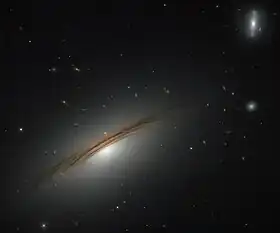| UGC 12591 | |
|---|---|
 UGC 12591, taken by the Hubble Space Telescope | |
| Observation data (J2000 epoch) | |
| Constellation | Pegasus |
| Right ascension | 23h 25m 21.7s[1] |
| Declination | ±00° 00′ 00″[1] |
| Redshift | 0.023179[2] |
| Heliocentric radial velocity | 6949 ± 10[2] |
| Distance | 394.26 ± 133.84 Mly (120.880 ± 41.036 Mpc)[2] |
| Apparent magnitude (B) | 13.90[2] |
| Characteristics | |
| Type | S0/a[2] |
| Mass | 1.9×1012[3] M☉ |
| Apparent size (V) | 1.7′ × 0.7′[2] |
| Other designations | |
| MCG +05-55-015, PGC 71392 | |
UGC 12591 is the third most massive known spiral galaxy, after ISOHDFS 27 and J2345-0449. It is located about 400 million light-years away from the Earth in the constellation Pegasus. In addition, it is the spiral galaxy with the highest known rotational speed[3] of about 500 km/s, almost twice that of our galaxy, the Milky Way. The high rotational speed means the galaxy must be very massive at the center; the galaxy has a mass estimated at 4 times that of the Milky Way,[4] making it the third of the most massive spiral galaxies known to date.
UGC 12591 is relatively isolated; the nearest galaxy to it is 3.55 million light-years (1.09 Mpc) away. However, its morphology suggests a merger or accretion event in its past: it is somewhat lenticular-like, with a central bulge and dust lanes reminiscent of the Sombrero Galaxy.[5]
References
- 1 2 Myers, S. T.; Jackson, N. J.; Browne, I. W. A.; De Bruyn, A. G.; Pearson, T. J.; Readhead, A. C. S.; Wilkinson, P. N.; Biggs, A. D.; Blandford, R. D.; Fassnacht, C. D.; Koopmans, L. V. E.; Marlow, D. R.; McKean, J. P.; Norbury, M. A.; Phillips, P. M.; Rusin, D.; Shepherd, M. C.; Sykes, C. M. (2003). "The Cosmic Lens All-Sky Survey - I. Source selection and observations". Monthly Notices of the Royal Astronomical Society. 341 (1): 1–12. arXiv:astro-ph/0211073. Bibcode:2003MNRAS.341....1M. doi:10.1046/j.1365-8711.2003.06256.x. S2CID 18706420.
- 1 2 3 4 5 6 "NED results for object UGC 12591". National Aeronautics and Space Administration / Infrared Processing and Analysis Center. Retrieved 16 April 2017.
- 1 2 Giovanelli, R.; Haynes, M. P.; Rubin, V. C.; Ford, W. K. Jr. (1 February 1986). "UGC 12591 - The most rapidly rotating disk galaxy". The Astrophysical Journal Letters. 301: L7–L11. Bibcode:1986ApJ...301L...7G. doi:10.1086/184613. ISSN 0004-637X.
- ↑ "A remarkable galactic hybrid". ESA/Hubble. Retrieved 16 April 2017.
- ↑ Ray, Shankar; Bagchi, Joydeep; Dhiwar, Suraj; Pandge, M. B.; Mirakhor, Mohammad; Walker, Stephen A.; Mukherjee, Dipanjan (2022). "Hubble Space Telescope Captures UGC 12591: Bulge/Disc properties, star formation and 'missing baryons' census in a very massive and fast-spinning hybrid galaxy". Monthly Notices of the Royal Astronomical Society. 517 (1): 99–117. arXiv:2203.02885. Bibcode:2022MNRAS.517...99R. doi:10.1093/mnras/stac2683.
External links
 Media related to UGC 12591 at Wikimedia Commons
Media related to UGC 12591 at Wikimedia Commons